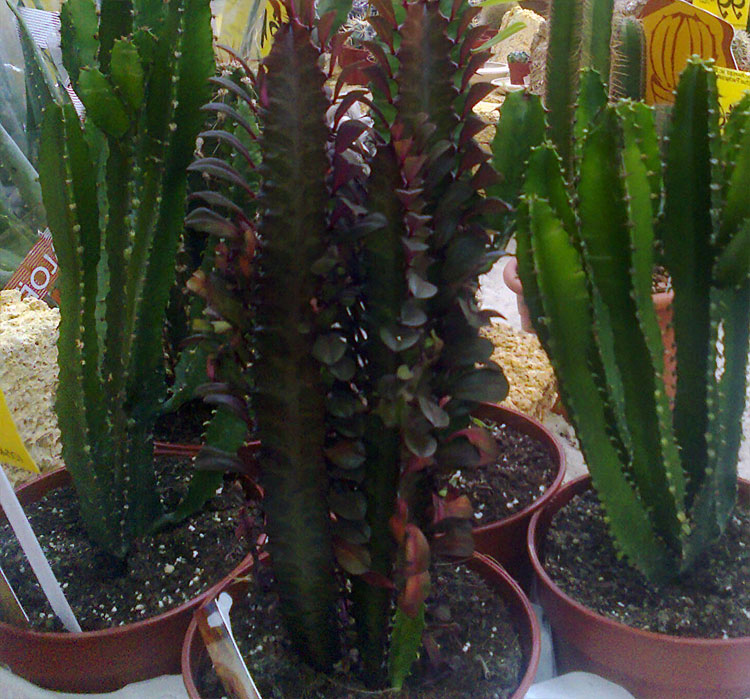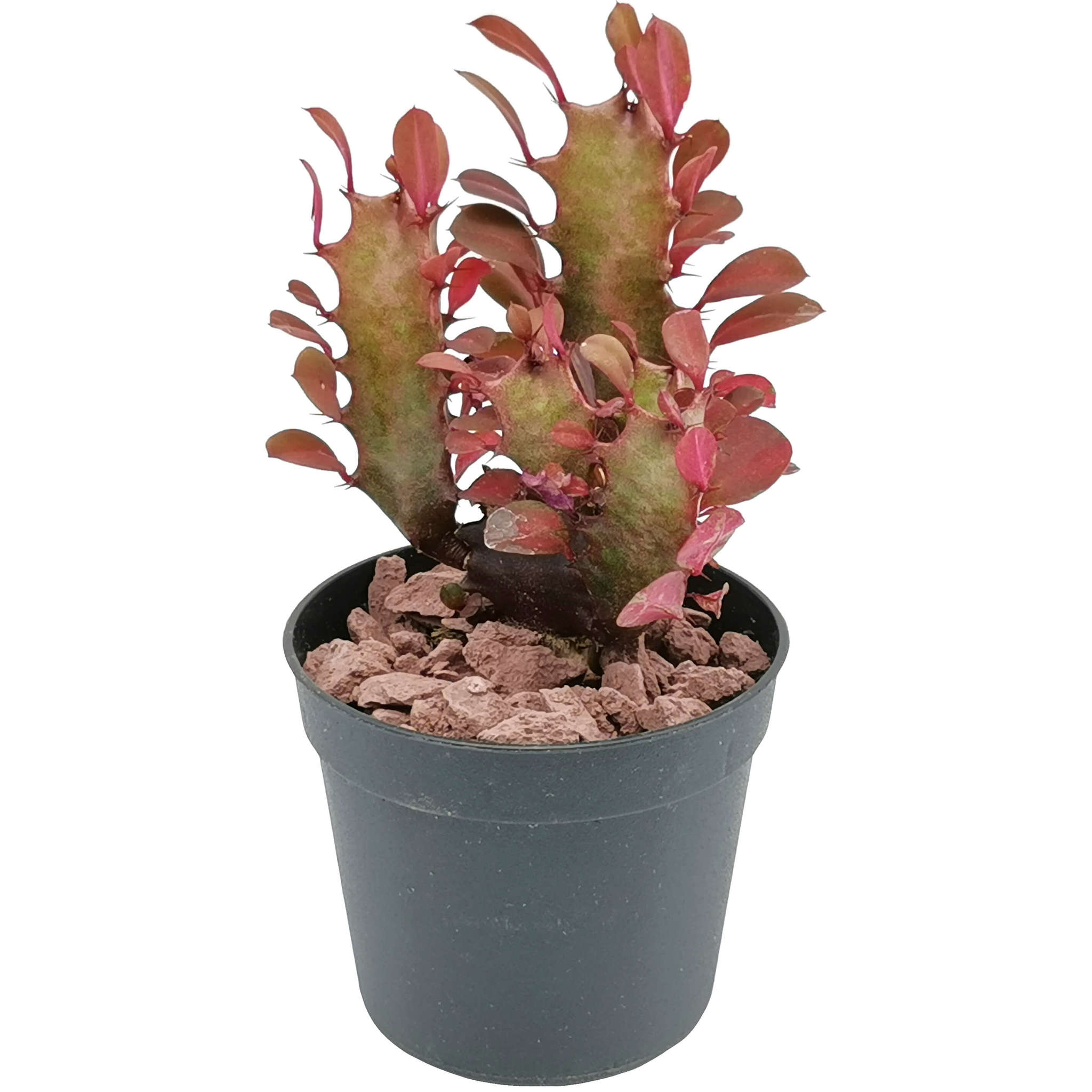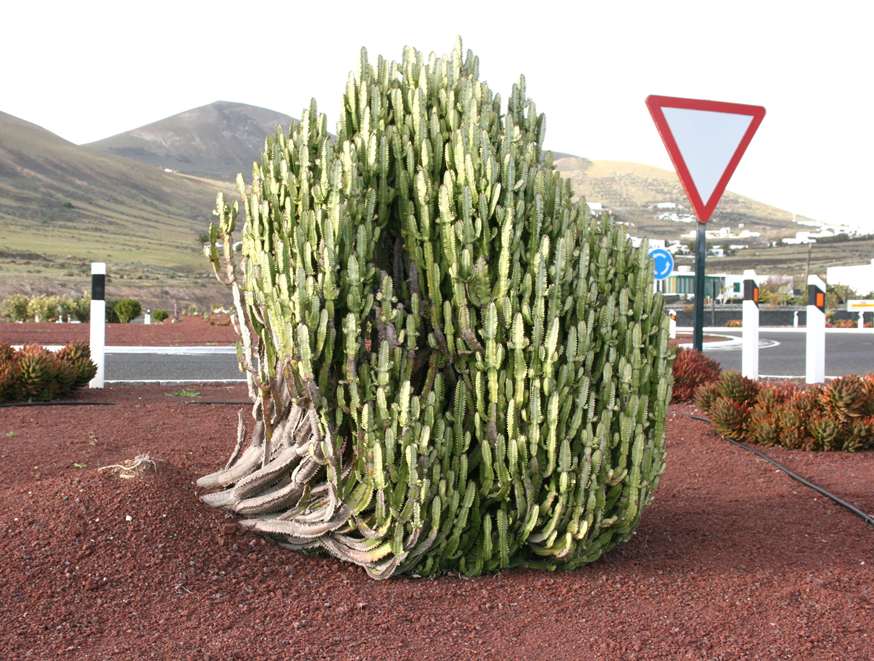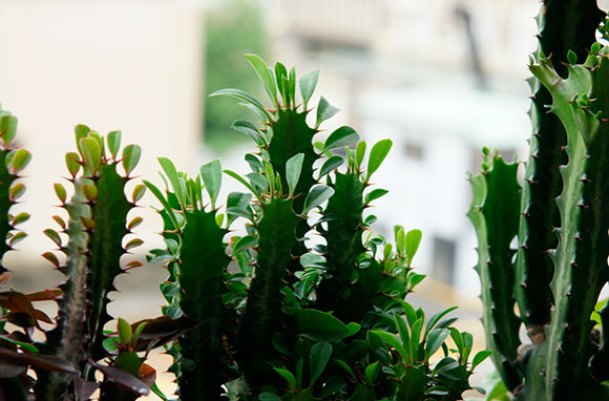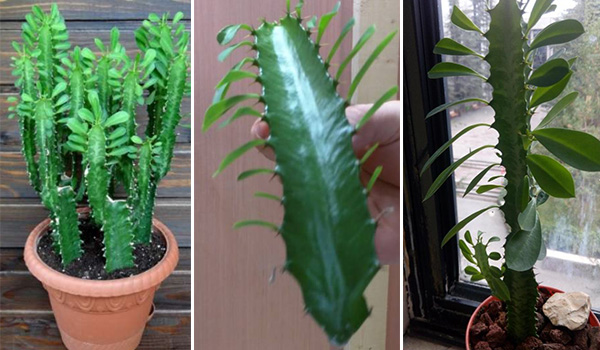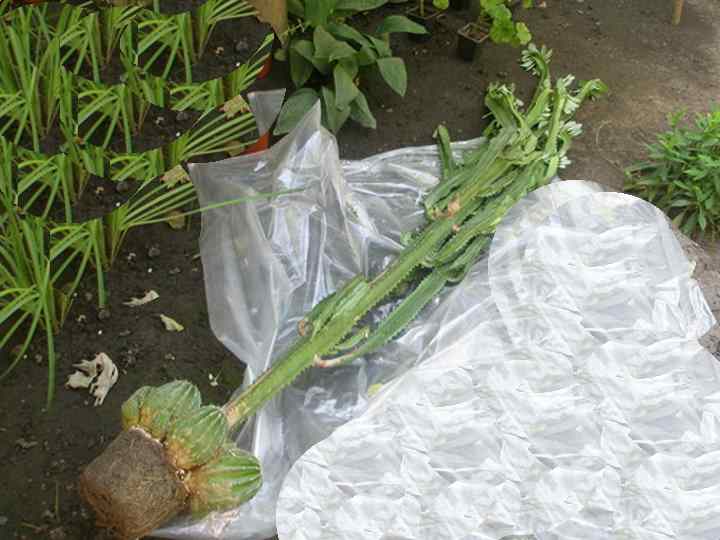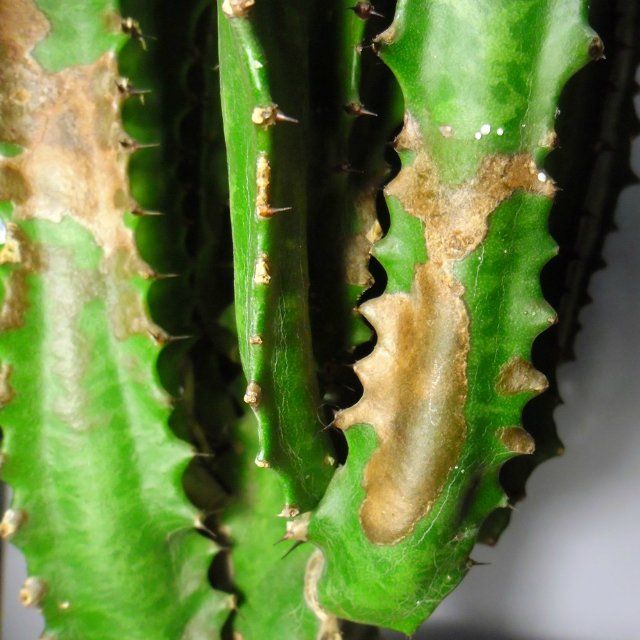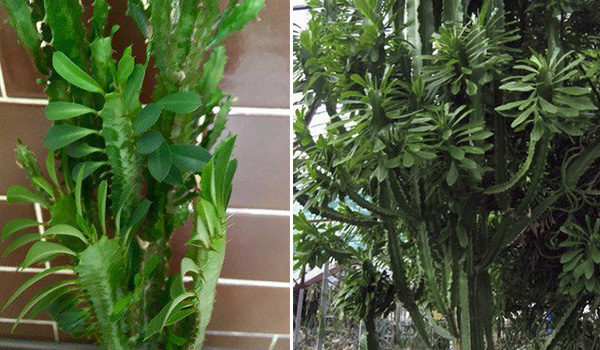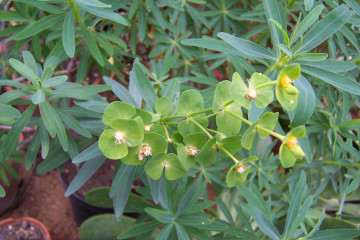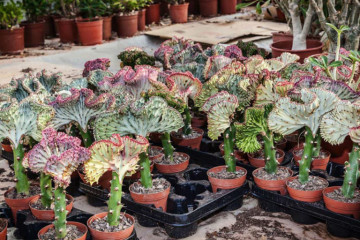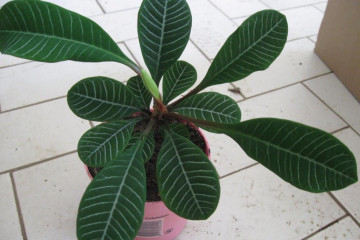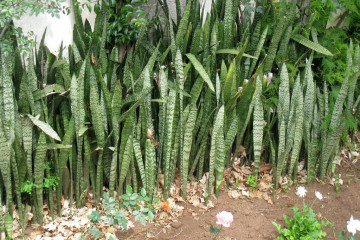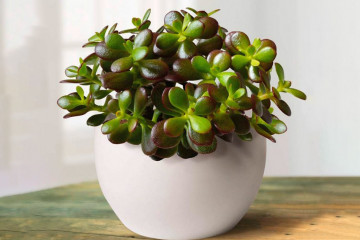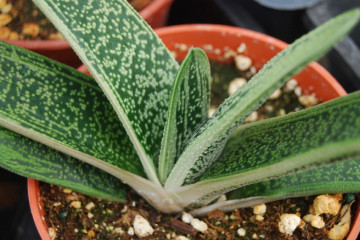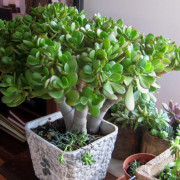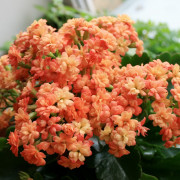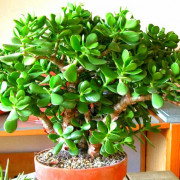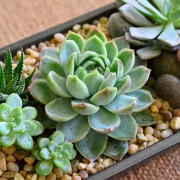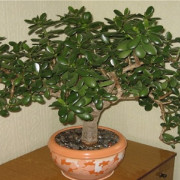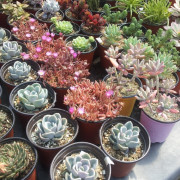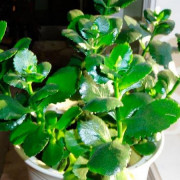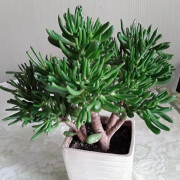Triangular spurge - home care
Content:
Trihedral spurge is a perennial plant, the popularity of which is due to its exotic species. The culture is used to decorate residential and office premises, personal plots, on its basis, traditional medicine is prepared. Euphorbia rarely gets sick, it is easy to care for it.
What does trihedral euphorbia look like, which family does it belong to?
It is a stem succulent with three faces, its second name is Euphorbia Trigona (in Latin), from the Euphorbia family. The culture is popularly called exocactus or Mexican cactus because of the external similarity of plants.
Euphorbia is trihedral, branched, it has many lateral shoots. The culture resembles a candlestick chandelier, grows rapidly, reaches several meters in height, but has a shallow root system. Considering these features, it is tied up, having previously installed a support, or planted in a deep pot with drainage and placed only in spacious rooms.
The fleshy stems of the trihedral milkweed are covered with numerous brown spines, on their tops are oblong leaves about 3-5 cm long. The color of the stems and leaves is dark green. There are unusual specimens with pink stems and red or purple leaves. The diameter of the trunk is 6 cm. Flowering occurs mainly in natural growing conditions, indoor crops rarely bloom.
Common varieties
Triangular spurge can be chosen for any interior. The most common indoor varieties include Suzanne, Mix, Gabizan, Rubra and Decari. The Rubra variety (Royal) is distinguished by dark red leaves, the presence of such a feature is due to a change in DNA.
All succulents of the Euphorbia family are rare species. It is an endangered plant in the wild.
Healing properties
For treatment, leaves, root, stems and juice are used. Euphorbia is an effective remedy for hemorrhoids and cystitis, with its help they get rid of tumor formations, tuberculosis, flu, colds.
The plant is effective in treating age spots and warts, skin diseases (fungus, eczema, lichen, burns, non-healing ulcers). You can take a bath with the addition of infusion or be treated with milkweed milk juice.
For diseases of the liver and stomach, a diluted decoction of the root is taken inside. Root-based tinctures are used to treat migraines. The use of triangular euphorbia is contraindicated in childhood, during the period of bearing and feeding a child, with serious pathologies of the cardiovascular system.
Briefly about the history of appearance
In the 54th century BC. e. the culture was named Euphorbia in honor of the court physician Eforba, since it was he who managed to find out what medicinal properties it possesses. You can find a plant on the island of Madagascar and in Central America. Potted cactus euphorbia triangular - an African guest, common in three climatic zones (subtropical, temperate, tropical).
Features of caring for a plant at home
Indoor triangular milkweed variety is unpretentious in care and pleasing to the eye all year round. The main thing is to take into account the characteristics of the plant.
Temperature
In autumn and winter, the culture prefers air temperatures above + 16 ... +18 ° C, in summer - + 20 ... +25 ° C. Despite the resistance of Euphorbia triangular to unfavorable factors, one should avoid sudden changes in temperature and a strong decrease in its values.
Lighting
To ensure active growth, a pot of triangular milkweed is placed in the brightest place from the south-west or south side, the main thing is not from the north. When this condition is not met, the decorative properties of the culture are lost, development slows down. Usually young plants are left on the windowsills, adults are placed near the windows. In the autumn-winter period, artificial lighting is used.
After winter, the evergreen shrub is gradually accustomed to exposure to direct sunlight, otherwise burns may appear on the stems. The pot is periodically turned so that all parts of the milkweed have enough natural light. The plant is light-loving, but direct exposure to sunlight should be avoided.
Watering
Euphorbia is a drought-resistant culture, it accumulates moisture in tissues. The decorative appearance is preserved with moderate watering. In summer, the succulent is watered every 7 days, in winter - every 30 days, when kept in rooms with cool air - even less often. Warm, soft water is suitable for watering. Use the settled liquid, add it in small portions. During the growing season, regular watering is provided after the top layer dries out, so as not to slow down development and not to provoke root decay.
Spraying
The procedure is carried out for hygienic purposes to improve the appearance of the milkweed. A layer of dust is removed from the plant with a soft brush, then the soil is covered with a film and water is sprayed.
Humidity
For all types of milkweed, the air humidity in the house does not matter. The plant grows normally when the humidity is high and the pot is placed next to a heater or radiator.
Priming
When compiling a soil mixture, peat, leafy soil, sod and sand are taken. All components are used in equal proportions. To ensure high-quality drainage, crushed brick or small pebbles are prepared.
Top dressing
Young milkweed fertilize every month. Top dressing is applied from March to October in accordance with the instructions. Adult plants in the spring are fed 1 time, in the summer - 2. For these purposes, use complex mineral compositions intended for succulents.
Features of care in winter, dormant period
In winter, plants are provided with rest. Milkweed triangular care at home during this period is not required, it is enough to leave it in a cool room. Watering euphorbia is carried out when the soil is dry by 3 cm.
In winter, the stems do not lose their decorative effect, but euphorbia hardly grows. From the second half of October, every day from 6 pm to 8 am, it is recommended to keep the pots in the dark. You can cover plants with materials that do not allow light to pass through.
When and how it blooms
Indoors, flowering usually does not occur. triangular spurge is valued for the decorative appearance of the stems.
Pruning
When it is necessary to stop the growth of euphorbia, pruning is performed with a sharp knife. As a result, new shoots are formed, the shape of the bush changes, it becomes wider and more lush. After pruning, the shoots are treated with napkins, and then with chopped coal.
You do not need to cut the triangular spurge, but use another method: hold the red-hot knife at a distance of 2-3 mm from the top of the stem. As a result, it dies off, and new shoots grow.
How euphorbia multiplies
Spurge of this species can only be propagated by cuttings, other methods at home are ineffective and not used. Reproduction is carried out in the spring. For these purposes, young shoots located on the lateral shoots are cut off (the optimal length is 10 cm), and they are washed under warm running water to remove the juice.
One cutting is not enough, it is recommended to have a supply of shoots. The cuttings are left to dry and wither for 2-3 days. Crushed coal is applied to the sections. To root the cuttings, they are planted in wet river sand or perlite. The container is taken out into a warm and well-lit room, protected from the aggressive effects of the sun. Rooted seedlings are moved to permanent pots.
Transfer
Young plants need to be transplanted annually. Adult specimens are moved to a new pot when there is not enough space in the old one for further root development - after about 2-3 years. Each subsequent pot is taken 3-4 cm wider than the old one. The plant is planted in the spring. The top layer of the earth is renewed annually.
The root is gently washed. A drainage layer is first laid out in a new pot, then, holding the spurge, 4-5 cm of soil for succulents. Tall specimens are planted in pots with heavy stones and, if necessary, tied to a support.
Possible growing problems and diseases
Many problems associated with growing crops arise from improper care. The risk of being damaged by pests in this case also increases.
The plant sheds leaves
With constant waterlogging of the soil, moisture stagnates. There is a risk of root rot and leaf fall. The same problem can appear with poor drainage and infection of the cut areas. To save the plant, it is transplanted. For preventive purposes, they are treated with fungicides.
Leaves turn pale
If the triangular milkweed lacks nutrients, or their intake is excessive, the leaves may lighten. To solve the problem, it is enough to adjust the feeding regime.
The tips of the leaves dry
When the plant is exposed to direct sunlight for a long time, brown patches appear on the surface of the leaves. The problem is corrected by changing the lighting level.
Pests
Triangular spurge can infect mealybugs. In this case, the upper part of the bush is covered with a white bloom. The defeat of the red spider mite is determined by the cobweb on the leaves. Aphids are also not afraid of poisonous juice, it scares away other pests.
Among other signs of damage to the triangular pest of milkweed are slow growth, stickiness, minor damage to the trunk. The problem is solved by using insecticides and acaricides. If there are a lot of insects, a single treatment is not enough, there should be at least 3 of them with an interval of 10 days.
Other problems
After prolonged waterlogging, the stems of the plant become stained. If the pot does not fit, growth retardation is observed. When there is not enough natural light for milkweed, the stems are noticeably stretched.
Signs and superstitions
The plant is popularly valued not only for its medicinal properties, but also for other features:
- Trihedral spurge is perceived as an energy protector of the home, since its surface is covered with thorns. Given this feature, the pot is placed near the entrance to the dwelling.
- Euphorbia is not placed in the bedroom. It is believed to release substances that can disrupt the quality of sex life and proper sleep.
- The plant does not bloom indoors, but if it suddenly bloomed, this is a good sign. Family members will be lucky in some way or their financial condition will improve.
The plant is able to prevent the appearance of an unpleasant odor in the house, absorb carbon dioxide and electromagnetic radiation, it is used in medicine, does not self-cure, only under the supervision of a doctor. When working with euphorbia, you can get hurt by thorns and get burned or poisoned with milky juice, but if you are careful and provide proper care, the benefits will significantly outweigh the possible harm.
